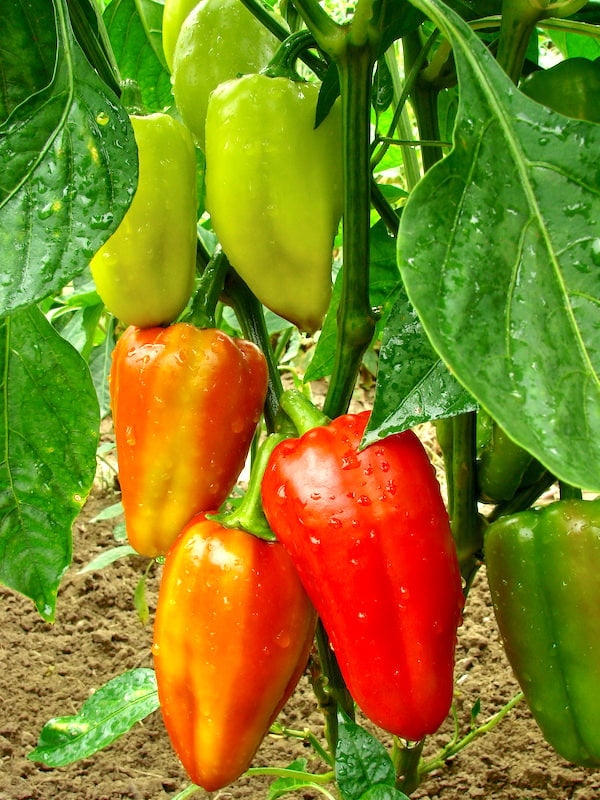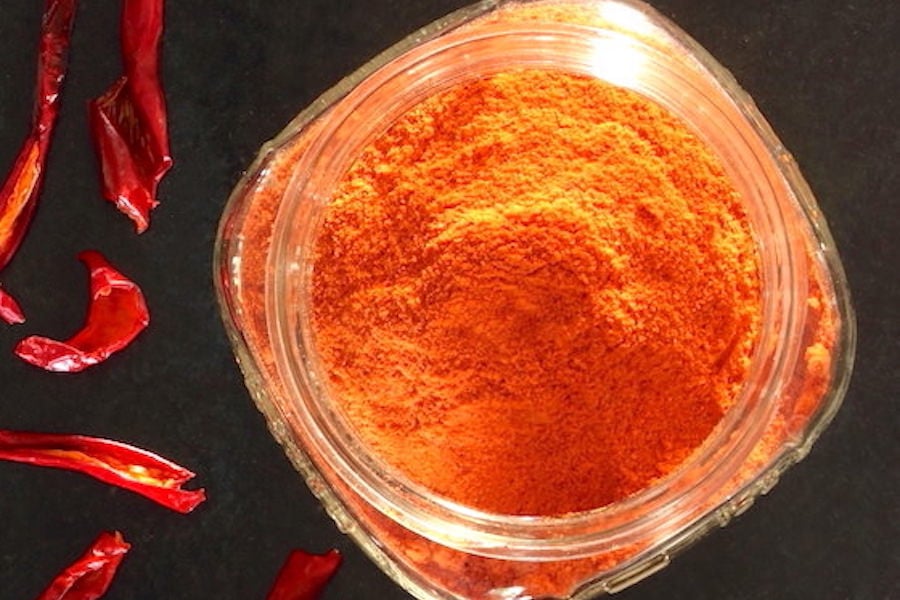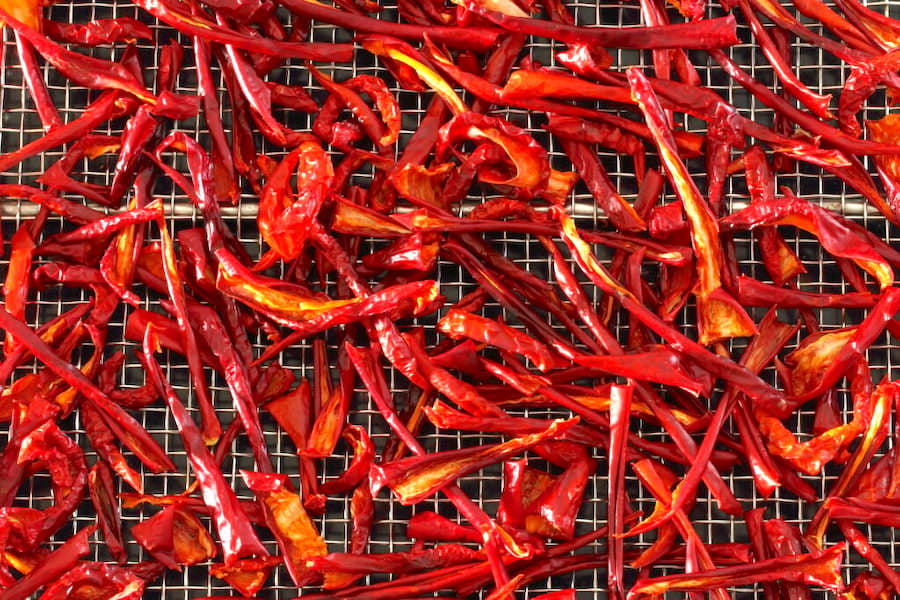Read on and learn how to make paprika at home – it’s actually really easy! Learn about pepper varieties, two methods for drying them, grinding the dried peppers into powder, and how to store the powder.
If you’re like me, you use paprika often when creating savory dishes. I was actually late to the “paprika party” – I didn’t start cooking with it until my son Kevin gave me a container of Hungarian paprika about ten years ago. Paprika has been flowing in my kitchen ever since 🙂 We love it so much that my husband started growing peppers just for this purpose.

Method Overview
- Grow or buy peppers suitable for making paprika
- Dehydrate the peppers thoroughly
- Grind into powder
- Store the paprika
Choosing Paprika Pepper Plants
Technically any pepper can be used to make paprika powder. Hot peppers (such as chilis) make hot paprika, sweet peppers make sweet paprika, and if you smoke the peppers while they are drying you end up with smoked paprika. Some folks like to blend pepper varieties for a unique flavor.
We buy most of our seeds through the Fedco Seeds catalogue. They offer three organic varieties that are meant for making paprika: Bolddog Hungarian Spice, Feher Ozon, and Karlo. So far Jamie has grown the Karlo variety. The resulting paprika is fresh tasting, earthy, and a fantastic balance of semi-sweet and semi-hot. In-other-words, it’s perfect.

Did you know that most peppers turn red if left on the plant long enough – and green peppers such as green bells and green jalapeños are actually not yet fully ripened? Instead of turning red, some varieties turn yellow or orange. Others even turn white, chocolate brown, or purple when ready to harvest. A sweet variety will taste sweeter and a hot variety will taste hotter if left to fully ripen.
Drying Paprika Peppers
There are two methods for drying peppers. The first method involves the use of a dehydrator and the second method involves hanging the peppers to dry over time. Both methods are described below.
Drying peppers in a dehydrator
The goal is to remove all of the moisture from the peppers, without cooking them. That’s why dehydrators, with their range of low temperatures, works better for this purpose than an oven. A dehydrator with a thermostat, fan, and timer is desirable. A more low tech dehydrator will also get the job done but will require more careful attention. I used to have a no frills model and found that the trays needed to be rotated more frequently.
My hands are very sensitive to capsaicin, so whenever I cut up garden peppers I always wear gloves (if the peppers are really hot I even wear a mask). Even if the pepper is supposed to be sweet, I err on the side of caution and protect my hands. We’ve had our sweet peppers cross-pollinate with our hot peppers more than once, creating a hot surprise. We’ve learned that the solution is to plant them in separate gardens that are at least 400 feet apart.

Cutting
Start by washing and draining the peppers. Cut them into strips that are about 1/2″ wide.
Seeds
Seeds contain the most heat, so when working with hot peppers remove all of the seeds or leave some of them depending on the level of heat you are aiming for. For sweet peppers discard the seeds.
Temperature
Arrange the pepper strips on the dehydrator trays single layer. Put the trays into the dehydrator and turn it on; set the temperature to 135ºF if there’s a thermostat.
Rotate the trays occasionally if you have a thermostat and fan. If you don’t have a thermostat and fan rotate the trays often.
Time
Dehydrate until the pepper strips are completely dry and brittle. This will take at least 12 hours. Once the peppers are brittle, I like to turn the temperature down and let it go another couple of hours just to be sure there is no moisture left.
When ready
When they are done, let the strips completely cool down before placing them in glass jars with tight fitting lids. Store in a cool, dark, dry place such as a pantry until you’re ready to grind into powder.
How to dry peppers without a dehydrator
The hanging method takes longer for the peppers to dry. Depending on the size of the pepper, the temperature, and humidity – it can take many weeks for them to be fully dehydrated. The best location for this method is dry and well ventilated. Hanging them in direct sun will result in faded, less flavorful peppers so a shady spot is preferable. If they are hung in a humid environment, the peppers may mold before they have a chance to dry. If you live in an arid location and can hang them in the shade, then this method may be perfect for you. I live in New England and I have successfully dried peppers using this method, but I must admit that some of them did grow mold inside – and they took a long time.
Begin by washing and draining the peppers. Thread a large sewing needle with sturdy thread that’s about an arm’s length, and make a knot at the end. It helps to stick a toothpick through the knot so the peppers don’t slide off. Pass the thread sideways through the cap of the first pepper. Continue sewing each pepper this way, and arrange them so air can circulate. Make a loop at the end of the thread and hang in a dry, well ventilated, shady location.
When the peppers are very brittle they are ready. Put them into glass jars with tight fitting lids and store in a cool, dark, dry place such as a pantry until you’re ready to grind into powder.
Methods for Grinding into Powder
If you dehydrate a lot of peppers, there’s no reason to grind all of them at once. Instead, grind into paprika as needed.
Use a bullet blender, spice grinder, or coffee grinder to powder the dried peppers. Afterwards, use a fine mesh strainer to separate any bits that didn’t become a fine powder. Reprocess those bits.
Please note that if you hung your peppers to dry whole, they will still contain the seeds, stems, and caps. As mentioned above, seeds contain the most heat. If you don’t want to grind up all of the seeds discard some or all of them before grinding. The stems and caps also need to be discarded beforehand.

How to Store Paprika
Store the paprika in a glass jar with a tight fitting lid. Add two or three dry beans to the jar to prevent the paprika from clumping; the beans will soak up any moisture that may be present.
FAQs
A half bushel of peppers cut into strips and dehydrated will fill about two quart jars (more if you dry the peppers whole). Each quart of dehydrated pepper strips will make about 2 cups of paprika powder. So basically, a half bushel of peppers will yield 4 cups (1 quart) of paprika powder.
Paprika contains natural salicylic acid and carotenoids. Orange paprika also contains zeaxanthin; hot paprika contains capsaicin. The beneficial activities of these phytonutrients help our gastrointestinal, cardiovascular, vision, and immune systems. They contain antioxidant, anticancer, and anti-inflammatory benefits. So yes, paprika is good for you!
Paprika is made solely from dried and ground peppers. Chili powder contains dried peppers but also other spices such as cumin and garlic powder.
In a pinch, you can substitute chili powder or cayenne pepper for hot paprika; start with less and taste before adding more. Ancho chili powder is a great substitute for sweet paprika; it’s made from poblano peppers. Sweet or hot paprika, and ancho chili powder can be used as a substitute for smoked.
Paprika won’t go bad as long as it’s kept dry. It will, over time, lose its flavor and nutrients so try to use within a year.
If you enjoyed this post, you may also enjoy How to Grill Peppers (roast and freeze).



Thank youi needed a little help. Lol
I hope my tutorial came in handy 🙂
We recently got a freeze dryer and will be making smoked and sweet paprika. To freeze dry, instead of dehydrating, I will smoke the peppers first, then slice and freeze dry. Once done I will powder them and store in mylar bags with O2 absorbers. I want to try my hand before traveling to Hungary in October – I want to see how I do compared to the authentic. Should be fun!
Love the advice given here but would suggest using something other than bushels and quarts to denote quantity. A measure by weight is more accurate.
Hi Sarah. This isn’t a recipe, but rather it describes a process – so exact amounts aren’t necessary. You can use as little as one ounce of peppers it you’d like. But the result will be a tiny amount of powder. Most folks that “put up the garden” deal in bushels or half bushels.
Thank you for the instructions! Is it possible to use green peppers for making the paprika? I had to strip all of the peppers off of my plant this evening due to fear of frost, so I have a bunch of green or sun-tanned ones that aren’t fully red.
Hi Samantha. We are in the same boat; we have a lot of green paprika peppers that probably won’t ripen. I’m not going to dehydrate them because they are not sweet, and won’t taste any better when dehydrated/powdered.